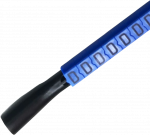The value of labeling cables
Properly labeled cables are an essential part of an effective structured cabling system and fiber network. Allowing for easier identification and quicker isolation of cables, it offers installers increased productivity, profitability, reliability, and safety. Let's break down the main benefits of a proper and reliable labeling system:
Enhanced productivity
Increased profitability
A higher level of safety
and security
Maintenance and troubleshooting can be simplified, reducing the need for repair and movement (both in terms of time and costs). With the ability to track cables, wires, and components at-a-glance, you can minimize downtime and keep operations running smoothly.
When you plan and label your materials correctly, you make the job easier for your workers. Your customers will see them as more professional. In turn, your business will be more profitable.
Additionally, labeling can be used to increase workplace security and compliance as well as increase efficiency, convenience, and clarity. Working on wires without labels can result in people unplugging or cutting the wrong ones, which can be very dangerous. Cutting through an incorrectly traced wire, for example, could result in electrocution. Unplugging a ground wire can result in a fire. There are many ways that wires can be hazardous, and a proper labeling system will help to minimize that danger.
Following best practices and standards when it comes to labeling is important. The TIA-606 voluntary standard recommends that you include on each label link identifiers that show the exact location the cable is running to and from. This information could include the floor number, closet, rack, patch panel, and port.
Effective labeling
For example, 2B.5-13.08/2B.1-1.24 tells us that the cable is run from the 2nd floor, closet B, rack 5, patch panel 13/port 8 to rack 1, patch panel 1/port24. This detail gives you exact specifications on where this cable runs to and from. Your expert structured cabling system installer should be aware of these standards and follow them effectively.
Other factors to keep in mind:
Consistency: Choose a consistent labeling format and stick to it! This makes it easier to trace any cable anywhere. Color coding: Color-coded labels are incredibly popular and work similarly to color-coded cables. You can choose colored labels to identify the type of network cable, which area it belongs to, or some other key piece of information. Co-ordinate with your overall cabling plans: Your labels should match the information on the plans saved for your structured cabling or facility. This makes it easy to identify and find cables whenever you need to work on the middle of the cables instead of the ends.
As with choosing your cabling system, quality is also important for your labels. Choose labels that are waterproof, won't smear, rip or scratch, and printed characters are best, not handwritten.
Durability: You will want your labels to stand the test of time and remain in place throughout your cable's life. There are various options when it comes to the label material, depending on your specific applications and environment. Vinyl labels are ideal for non-flat sub surfaces since they offer oil and dirt resistance; polyolefin labels are for a wet environment and are resistant to chemical and high temperatures; while nylon is the optimum choice for use on curved surfaces due to their flexible and strong features.
Permanent Print: Ensure that your network cables are labeled with a print that is permanent and won't smear or fade over time.
Cable Thickness: Depending on the thickness of your wires or cables, you need to decide which sleeves or self-laminating labels to use in order to make sure they'll fit. Generally, cable sleeves should have at least twice the height of the cable diameter, and very thick cables can be identified using straps and a cable bundle tag.
Cable Types: If you want to limit the contact surface between your wire or cable and your label, use a P- or T-shaped flag label to leave space for printing a code or bar-code on. When you need to identify cables or wires that are already attached, tags can be used as a non-adhesive alternative. And wraparounds and flag labels are a self-adhesive alternative for terminated cables.
What labels are best to use?
Introducing DINTEK's new Marker Identification System... ezi-LABELTM
and outdoor wiring. If the markers need to be changed, they can be removed without cutting off terminals and cables.
- Quick and simple to use pre-printed nylon Snap-On markers
- Ideal for use either pre or post-termination or for maintenance and repair
- Markers lock together to give perfect text alignment
- Vibration-resistant markers that grip onto wire and cable tightly
- Applicator tool holds a 20-marker strip
- Comes in Cat.5e, Cat.6 & Cat.6A sizes
- Gripping system locks markers onto wire and resists rotation
- Available as standard in White with black text
- Also available in Yellow, Green, Red, Blue & Orange
How to use







For more information on ezi-LABELTM click here







